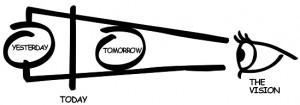Organizations will not be successful by making old ways more efficient. The competitive environment is changing so rapidly that a lean cost structure is no longer a differentiator. Instead, the advantage going forward will go to the companies that can develop a solidly different vision that tests their decisions based on what is best for their customers. What part do your customers play in your company's vision?
Michael V. Harper and General Gordon R. Sullivan, in Hope is Not a Method, offer one of the best descriptions of organizational vision I have read. The graphic accompanying this post illustrates their philosophy. Leadership must establish what the future will look like, and then look backward into how this future can be channeled in a focused manner through today's and tomorrow's actions. Sullivan writes, "I tried to mentally position myself in the future, and, in my mind's eye, look back. It is a technique used by distance runners and other athletes-they "see" themselves at the finish line and "look back" to pull themselves along."
 The diagram's funnel shape narrows because the vision helps an organization sort through all of the alternatives (many of which are fads) in order to concentrate on only those which will support the new destination. A company with a vision committed to its customers should base all decisions on how they will impact customers, not simply giving lip service to customer treatment.
The diagram's funnel shape narrows because the vision helps an organization sort through all of the alternatives (many of which are fads) in order to concentrate on only those which will support the new destination. A company with a vision committed to its customers should base all decisions on how they will impact customers, not simply giving lip service to customer treatment.
Even when their vision statements mention customers, too many companies go after this vision through low-level acts of customer service, representing good transactional performance, but not game-changing. Harper and Sullivan refer to this technique as Making Yesterday Perfect.
In one of their examples, they discuss General Electric's poor performance in 1981 before Jack Welch took charge. Instead of forward thinking, GE had "perfected the management model of the 1950s." It had 12,000 employees (8% of its workforce) operating in the finance and auditing functions. The book refers to this approach as the "management treadmill." Rather than reengineering old products and processes, 21st century organizations must re-orient instead. Clearly the best way to bring about enduring change is by focusing on solutions that are important to your customers.
"We must change the way we change." Working harder to do the same things better will not lead to success. Companies cannot build a winning organization by simply adapting to accommodate what is around them. "To win, you have to get out in front."
The future is created by positive steps, not wishful thinking. The danger of not making strong actions is not in losing your customers, although that will happen in the long run by clinging to old mindsets. The danger is in failing them and failing equates to not continually improving based on what customers need and value to make their lives better. Organizations that can integrate this thinking into their cultures are training employee change agents that are learning how to think like a customer at every touch-point.
"Management has to do with an organization's processes---performing them correctly and efficiently; leadership has to do with an organization's purposes." Leaders must create the future and articulate a vision by demonstrating a "line of sight" between today's marginal improvements and the desired future "quantum improvements" for customers. This future destination creates a context within which the organization can act.
This vision inspires commitment in employees to something larger than themselves. It develops a strong sense of purpose-building cathedrals instead of merely cutting stones, as the old story goes. Vision is a challenging concept because it forces people to change. But if the efforts are directed toward the customer, that kind of change becomes transformational.
To be successful, a vision also must be empowering. But that becomes second nature because employees will always embrace actions designed to create a future that will delight their customers.
"Vision is a sense of the future...forming a basis for looking ahead, not for affirming the past or the status quo." The best way to set this basis for transforming your company--to direct the path to the "after next" version of your organization, in other words--is through your customers. This translates the change in your employees' minds and causes near-term actions and expectations to be evaluated by thinking like a customer.
Be a builder, not a maintainer. Don't rethink your vision; instead, re-orient the commitment behind that vision through your customers.
